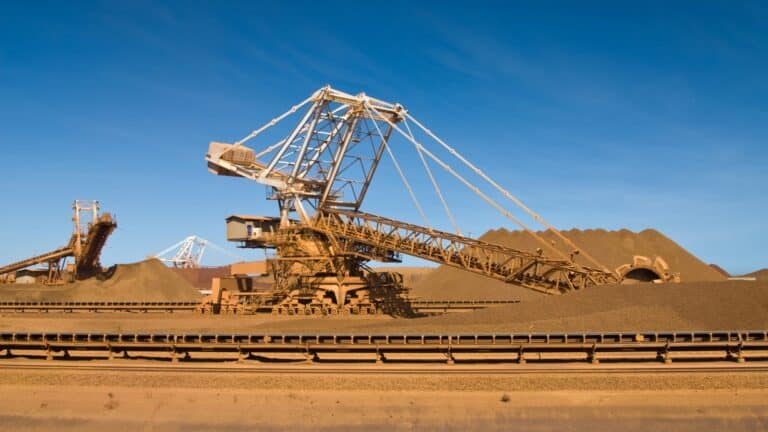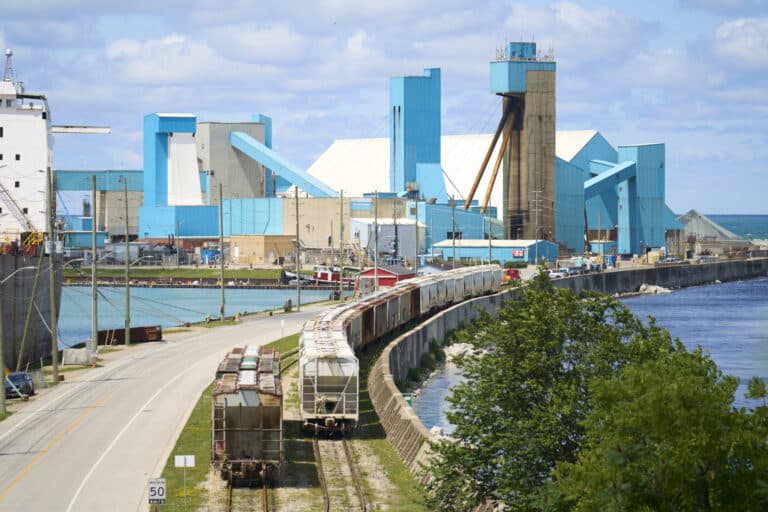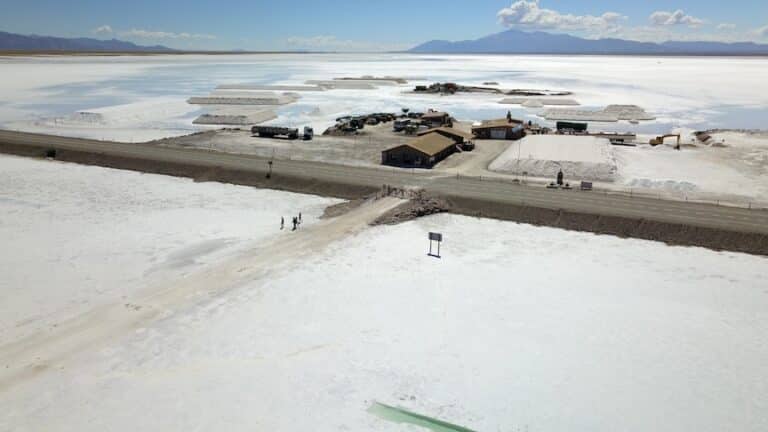Could a strategic lithium reserve kickstart US supply chain development?
NEW YORK -- A strategic lithium reserve is being mooted as a solution to stabilize volatile prices that have hindered American mining projects, allowi
Current Access Level “I” – ID Only: CUID holders, alumni, and approved guests only
Insights from the Center on Global Energy Policy
This Energy Explained post represents the research and views of the author(s). It does not necessarily represent the views of the Center on Global Energy Policy. The piece may be subject to further revision.
Contributions to SIPA for the benefit of CGEP are general use gifts, which gives the Center discretion in how it allocates these funds. More information is available here. Rare cases of sponsored projects are clearly indicated.
The US Department of Defense has announced a multibillion-dollar public-private partnership with MP Materials, representing one of the most consequential federal efforts to build a secure, end-to-end domestic rare earths supply chain to date. In scope, structure, and strategic intent, this deal sets a precedent for how the US government could approach critical mineral security in the years ahead.
Without a doubt, this is a significant step toward the US goal of creating supply chain resilience in one of the most China-dominated critical minerals supply chains.
MP Materials, the operator of the only active and significant US rare earths mine located in Mountain Pass, California, has long been viewed as a key player in efforts to reduce reliance on Chinese rare earths. The new agreement with the DoD could accelerate this trajectory by providing a comprehensive financing and procurement package that supports both upstream mineral processing and downstream magnet production.
At the center of the deal is the construction of MP’s second magnet manufacturing plant—referred to as the “10X Facility,” which will add an estimated 10,000 metric tons per year of neodymium-iron-boron (NdFeB) magnet production capacity when commissioned in 2028. Once operational, this facility would significantly scale up US capabilities in permanent magnet manufacturing, critical in both defense and commercial applications, including fighter jets, drones, electric vehicles, wind turbines, and other advanced technologies.
To de-risk the build-out and improve long-term investment viability, the DoD has committed to a 10-year offtake agreement for 100 percent of the facility’s magnet production. Critically, it has also introduced a 10-year price floor for neodymium-praseodymium (NdPr) oxide, set at $110 per kilogram (kg). This mechanism is aimed at ensuring MP Materials receives predictable revenue even if global prices fall due to a ramp up in China’s output. This has happened in recent years, with excess capacity depressing prices, which hurt non-Chinese projects. The current market price for NdPr inside China is under $60/kg, so the price floor operates as a subsidy and market stabilizer.
In addition to these two game-changing commercial commitments, the government will become the company’s largest shareholder through the purchase of $400 million in newly created preferred stock, convertible into common equity. Combined with a warrant to acquire further equity, this will give the US government an effective 15 percent stake in MP Materials.
In a sign that public market-making instruments can unlock private capital, financing for the 10X Facility will now also include $1 billion in commercial debt from JPMorgan Chase and Goldman Sachs, while the DoD will separately extend a $150 million loan to support the expansion of MP’s rare earth separation capabilities at Mountain Pass.
MP Materials is already commissioning a smaller magnet manufacturing facility in Texas, which is expected to come online in 2026 with 1,000 metric tons of capacity. Together, the Texas plant and the forthcoming 10X Facility will give the United States a vertically integrated rare earths-to-magnets supply chain for the first time in decades. This includes domestic mining, refining, oxide production, metallization, and the fabrication of final magnets.
This would represent the build-up of rare earths industrial capability that was lost to Asia in the early 2000s and has yet to be fully rebuilt anywhere in the West. MP’s two magnet facilities would exceed projected defense demand by the end of the decade, allowing them to sell to commercial industries. However, it remains to be seen how MPwill compete with Chinese and Japanese magnet producers on price.
The government support also comes at an important time for MP Materials. In April, it announced that it had stopped selling rare earths concentrate to China for separation because tariffs made it uneconomical. China was a key revenue stream for MP due to its rare earths separation capabilities. The government support, combined with MP’s existing expansion plans, will now allow them to completely pivot away from China.
MP Materials confirmed that it would make investments in the process to separate heavy rare earth elements (HREEs), although this could be speculative for now. This is due to the fact that Mountain Pass is primarily rich in light rare earths like neodymium and praseodymium, but contains only small amounts of heavy rare earths such as dysprosium and terbium that are critical for high-temperature magnets used in defense.
For heavy rare earths, China accounts for nearly 90 percent of extraction and controls nearly all downstream separation and processing capacity. This makes it basically the sole viable supplier of heavy rare earth elements today.
China placed export restrictions on heavy rare earth elements in April. Even after China eased those restrictions, the prices of key heavy rare earths such as yttrium, terbium, and dysprosium remained, respectively 598 percent, 195 percent, and 168 percent above their levels before the export restrictions first came into effect in April.
The overall challenge with heavy rare earths is twofold. First,separation is the critical bottleneck for heavy rare earth elements outside of China. Even when there is extraction of rare earths, without separation capacity, mined heavy rare earths cannot be converted into usable inputs for high-performance magnets or other advanced technologies. China knows this, which is why it has started to control its main rare earths technical experts and engineers, including taking away passports of Chinese nationals with rare earths expertise to prevent them from building rare earths capacity and know how in other countries.
While a handful of Western companies are developing mining projects with HREE content, virtually no industrial-scale capacity exists outside China to separate and refine these elements. MP Materials plans to begin separating heavy rare earths, but they will need to prove that they can ramp up to full commercialization.
Separation is technically complex and requires highly specialized solvent extraction processes and infrastructure that China has built over decades. Even where modest separation capabilities exist (examples are Solvay in France and Lynas in Malaysia) or plans are in the making (such as REEtec in Norway), nearly all projects are either small-scale, underutilized, or lack consistent feedstock.
Feedstock availability does remain an important second challenge.Most rare earth mines outside China are heavily skewed toward light rare earths, with limited content of heavy rare earth. To fully maximize this deal, the United States may need to provide additional policy and de-risking support to an HREE mine abroad.
HREE deposits are mainly found in China and Southeast Asia. Vietnam is a potential long-term partner on HREEs, but the best immediate options would be existing or soon-to-be producing HREE mines in Brazil, like Serra Verde or Aclara. The Development Finance Corporation or EXIM, through their Supply Chain Resiliency Initiative, could provide financing to these projects to allow them to expand and have their feedstock be tolled through MP. Any potential deal with a Brazilian mine, however, could be made more difficult due to the potential 50 percent tariff that the United States has said it may place on Brazil.
This agreement signals a shift in how the United States approaches critical minerals, no longer viewing them as purely commercial commodities, but as strategic assets that require long-term public support. The Pentagon has effectively moved from being a passive buyer of components to an equity investor and anchor customer of the upstream, midstream, and downstream materials on which its own defense systems rely.
The DoD-MP deal is not without risk, though. MP Materials is only beginning to expand into magnet production and needs to prove its capabilities in heavy rare earths separation and magnet production at commercial scale. However, its ability to navigate the market over the last few years may give DoD confidence.
Such a risk may well have been necessary if the DoD wants to build a supply chain not reliant on China, and now they have proven they will. It may prove to be a sign that Washington is now less worried about the risk of another Solyndra and more about the risk of shuttered factories due to missing components.
It remains to be seen whether the introduction of a price floor and long-term offtake agreements for rare earths and magnets will be replicated for other commodities. Perhaps the unique position that rare earths occupy—critical for defense, subject to Chinese export restrictions, and small enough in market size to justify direct government intervention without excessive cost—means that this combination of instruments will not be easily replicated elsewhere. Indeed, extending similar price support to larger or less defense-critical commodities might require far greater taxpayer funding and may be less justifiable. While picking winners may work in rare earths, the United States may now want to develop a broader and more cost-effective market-making playbook to diversify and secure critical materials supply across the board.
The new critical minerals agreement between Japan and the US is more than yet another bilateral trade announcement.

The Trump administration is increasingly using equity investments as a tool of industrial policy to support domestic critical minerals supply chains.

This special CGEP blog series, featuring six contributions from CGEP scholars, analyzes the potential impacts of the OBBBA across a range of sectors.

On April 30, 2025, the United States and Ukraine signed a long-anticipated economic partnership agreement establishing the US–Ukraine Reconstruction Investment Fund.

The report outlines five foundational choices if a stockpiling strategy is adopted, as bipartisan support suggests is possible.

Natural resources and critical minerals are more important than ever. Here's how Canada can be a global leader

Lithium plays a critical role in the global energy transition. It is the core ingredient of lithium-ion batteries that power electric vehicles (EVs) and are used in stationary energy storage systems.
